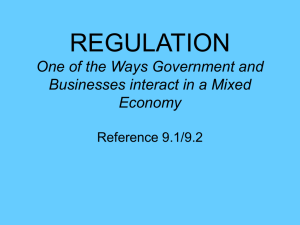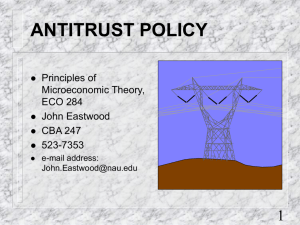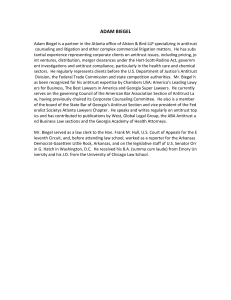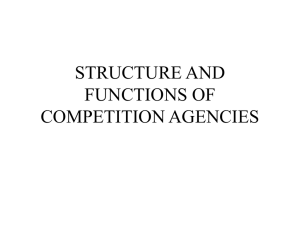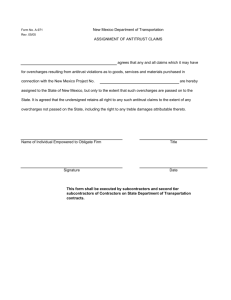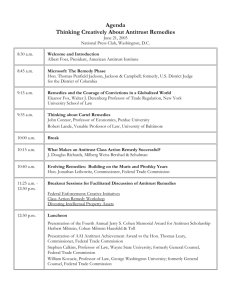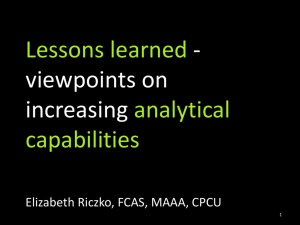Inside Counsel Antitrust Update
advertisement
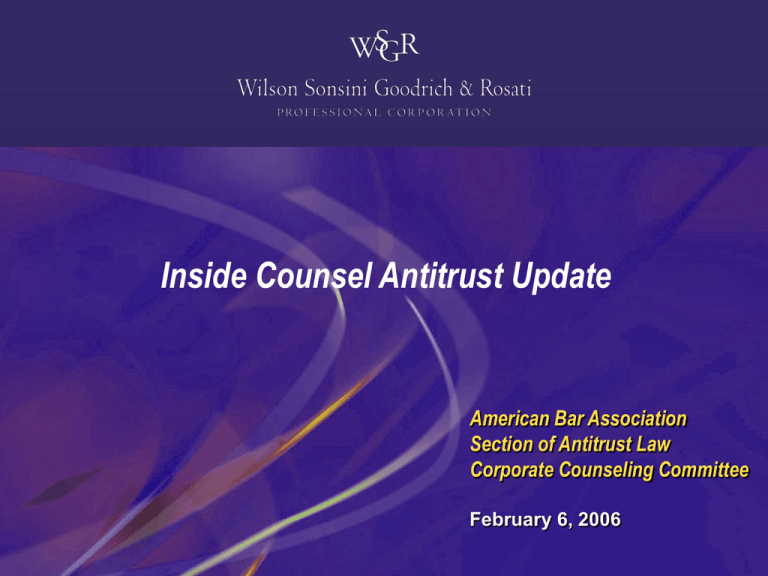
Inside Counsel Antitrust Update American Bar Association Section of Antitrust Law Corporate Counseling Committee February 6, 2006 New Development Topics The Supreme Court (Compton/Jacobson) Private litigation (Jacobson) The agencies (Biggio/Sher) • DOJ • FTC The EU (Biggio/Sher) The Modernization Commission (Jacobson) Intellectual property/Antitrust (Compton) 1 Supreme Court Developments 2 Supreme Court Developments Volvo • Volvo Trucks North America v. Reeder-Simco GMC, Inc., 126 S. Ct. 860 (Jan. 10, 2006), rev’g 374 F.3d 701 (8th Cir. 2005) – Held: no Robinson-Patman liability in a bidding context where the “disfavored” dealer is not competing against other dealers for the same retail customer’s bid – Under the ruling, there must be head-to-head customer competition for the same customers to invoke RP; here, there were just two bids: • In one, both dealers were offered same discount, but neither dealer won the bid. In the other, Volvo initially offered same discount to competing dealers but, after competitor won bid, increased the discount. Even there, alleged $30K in lost profits on a single transaction did not amount to the “substantial” competitive injury needed to violate RP. – Court sided with Volvo and U.S. as amicus curiae – Thomas and Stevens dissented to Court’s “novel, transaction-specific concept of competition.” 3 Supreme Court Developments Volvo • Key take-aways: – There must be repeated instances of discrimination in contexts where the favored and disfavored buyers are competing for the same customers • Requisite competitive injury in secondary-line price discrimination case (injury to competing buyers) is diversion of sales or profits from disfavored purchaser to favored purchaser; no inference of competitive injury where other dealers got greater discounts in bidding situations in which plaintiff did not participate – RP Act must be read consistent with general antitrust concern with interbrand competition, not protecting individual competitors • At least suggests further narrowing of RP scope • Does it also portend a Brunswick requirement for RP cases? 4 Supreme Court Developments Volvo • Key take-aways: – Articulates rigorous standard of proof of fact of injury • “Reeder simply paired occasions on which it competed with nonVolvo dealers for a sale to Customer A with instances in which other Volvo dealers competed with non-Volvo dealers for a sale to Customer B. The compared incidents were tied to no systematic study and were separated in time by as many as seven months. . . . We decline to permit an inference of competitive injury from evidence of such a mix-and-match, manipulable quality.” – Will this leak into Sherman Act cases? If so, how far? • Plan a Westlaw search for “mix-and-match, manipulable” and “no systematic study” for this time next year 5 Supreme Court Developments Weyerhaeuser: • Ninth Circuit held that Weyerhaeuser was guilty of predatory buying by paying “more than necessary” for logs in Pacific Northwest – Said Brooke Group is inapplicable in buying cases • Supreme Court asked Solicitor General to file a “views” brief as to whether certiorari should be granted • No deadline, but brief expected by late May, to allow Court to decide the petition by the end of its term in late June • Solicitor General will get input from DOJ and FTC • Parties and amici have been meeting with the agencies in the last few weeks to seek support for their positions – Real issue is not whether the decision was correct, but whether this is the time and place for Supreme Court review 6 Supreme Court Developments Schering-Plough: • Another SG views invitation – Under what circumstances, if at all, does a patent settlement that delays generic market entry in return for substantial “reverse” payments by the branded drug manufacturer violate the Sherman Act? • Fairly clear circuit conflict – Compare Schering-Plough Corp. v. FTC, 402 F.3d 1056 (11th Cir. 2005) and In re Tamoxifen Citrate Antitrust Litigation, 429 F.3d 370 (2d Cir. 2005) with In re Cardizem CD Antitrust Litig., 332 F.3d 896 (6th Cir. 2003) • Will the SG support the FTC? – Stock up on earplugs if not – See Schering-Plough Corp., 2003 WL 22989651 ( FTC 2003) 7 Supreme Court Developments Still awaiting decisions in • Texaco v. Dagher – Argued January 10th; justices exhibited substantial doubt whether joint price setting by the members of a lawful joint venture could reasonably be subject to the per se rule • Independent Ink – Argued November 29th; question is longstanding market power presumption for patents and copyrights; some justices also questioned per se tying rule generally • One or two decisions before Spring Meeting? – Reversals in both cases expected Certiorari denials in • Dentsply • Empagran 8 Supreme Court Developments Alito confirmation • No effect on antitrust cases; O’Connor was a defense vote in every close case • The real antitrust change, if there is one, is replacing Rehnquist with Roberts – Rehnquist was not a certain defense vote; voted for the plaintiff in Kodak, Summit Health, Allied Tube, Monsanto 9 Private Litigation 10 Private Litigation Heerwagen v. Clear Channel , 2006 WL 45859 (2d Cir. 2006): • Second Circuit affirmed denial of class certification – Case involved a claim that Clear Channel had monopolized the market for rock concerts throughout the United States – Plaintiff sought certification of a national class of retail purchasers of tickets to live rock concerts • Certification was challenged on the ground that the relevant geographic market was plainly not national and that a national class was therefore inappropriate – District court agreed, and Second Circuit affirmed • Evidence demonstrated that there is no cross-elasticity of demand for tickets, for example, between Seattle and Miami – “Duh” 11 Private Litigation Heerwagen v. Clear Channel: • Decision potentially significant in two respects – First, the decision confirms that proof of a relevant market is an essential element of any claim under Sherman Act § 2 • Plaintiff can try to prove power directly, but must do so in the context of a market that has been properly defined – Second, makes it feasible for a defendant to mount a real defense to class certification • Plaintiff must prove each element of Rule 23 by a preponderance of the evidence and cannot, if challenged, rely just on allegations in the complaint • Court may consider the expert testimony from both sides and may rely on defendant’s expert analysis if it is more persuasive • Certification denied with virtually no discovery – just expert reports, deposition of named plaintiff 12 Private Litigation UAC v. Avaya, 2006 WL 126623 (N.D. Ill. Jan. 12, 2006): • Plaintiffs sought preliminary injunction to stop Avaya from executing a program that would eliminate independent service of Avaya PBXs • Injunction denied; court finds that the case is significantly different from Kodak – “UAC is exposed as seeking to compel Avaya to grant licenses that would give unauthorized party UAC access to Avaya's wholly proprietary intellectual property embedded in software, a kind of ‘cooperation’ that Avaya has not volunteered in the past.” • Kodak, in contrast, involved a sharp break from past practice and, at the Supreme Court level at least, there was no issue about requiring a license to the defendant’s IP rights. – Serious questions raised with regard to plaintiffs’ claim, including whether Avaya had a business justification for its program; whether plaintiffs had standing to bring suit; and whether the relevant market was properly defined • The decision was written so favorably for Avaya, it seems unlikely that the case will ever make it to trial 13 Private Litigation Applied Medical Resources Corp. v. Ethicon, 03-1329-JVS (C.D. Cal. Feb. 2, 2006): • Applied charged that Johnson & Johnson unlawfully bundled its “trocars” surgical devices (which Applied sold) with surgical devices which Applied did not sell and in which J&J had significant market power – Claims asserted under Sherman 1 and 2 • J&J moved for summary judgment on the grounds of a lack of proof of competitive harm • Motion denied, except as to post-2003 agreements that carved Applied products out so that they were no longer impacted by the bundling • Court looked to J&J’s practices in the aggregate and, applying a rule of reason analysis under both Section 1 and Section 2, concluded that there was evidence that the overall effect was to increase prices and maintain J&J’s market power – Rejected defense that presence of a major rival, Tyco, precluded competitive harm 14 Private Litigation MDL 1720/Credit Card Interchange Cases: • JPML has consolidated in EDNY dozens of class and individual actions involving merchant claims of antitrust violations in the pricing of credit card acceptance to retailers • Visa and MasterCard are defendants in all cases; various bank members of these Associations are defendants in some; and American Express and Discover are named in a few • Many claims, but two are central – Whether the setting of interchange by the Associations amounts to unlawful price fixing (notwithstanding Nabanco, 779 F.2d 592 (11th Cir. 1986)) – Whether “no surcharge” rules by credit card firms are unlawful unilateral or vertical restraints • First hearing held January 12, 2006 15 Private Litigation Walsh v. Microsoft, 2005 WL 3636795 (D. Md. Dec. 29, 2005): • Allows removal of state cases to federal court under diversity jurisdiction if the claim of any unnamed class member exceeds $75,000 – Decisions on this issue conflict – Issue is less important than it used to be in antitrust cases given CAFA, and the greater ease of removal since CAFA was passed 16 What’s New at the Agencies 17 What’s new at DOJ Not much new: pretty slow month at DOJ • Senators Kyl and Brownback have dropped their holds on Tom Barnett’s nomination – WSJ had criticized Barnett because he did not disavow Hew Pate’s challenge to the Oracle/PeopleSoft deal, leading to Kyl-Brownback holds – Confirmation now expected soon since Alito confirmation is out of the way Only two new DOJ antitrust cases, both criminal • Alaska Brokerage – bid rigging of otter pelt furs • Elpida Memory • Two non-antitrust indictments 18 What’s new at DOJ Elpida Memory (Japan) • Another DRAM guilty plea • Fine of $84 million Elpida much smaller than other companies that have pleaded (Samsung, Infineon, Hynix) as well as the company that received amnesty (Micron) • Given Elpida’s lower sales, $84 million is a substantial fine In DRAM, the one U.S. company, Micron, received amnesty while each of the foreign companies has been prosecuted 19 What’s new at the FTC The Commission is back to full strength Tom Rosch confirmed and sworn in • Former Latham & Watkins Partner • Long-time and accomplished antitrust attorney William Kovacic confirmed and sworn in • Immediate former General Counsel of FTC • Professor of Antitrust Law at GWU Heralded as the most experienced FTC in years 20 What’s new at the FTC Time-Warner/Comcast/Adelphia • Commission closes 7-month investigation • Comcast and Time Warner to acquire cable properties of Adelphia, bringing together adjacent cable systems in some geographic markets • Foreclosure and cost-raising theories explored – Would transaction cause consumer harm by affecting the terms on which Comcast or Time Warner contract to carry regional sports networks? – Would the transaction cause Comcast or TWC to increase the prices at which they make available to other cable companies the right to carry regional sports networks in which Comcast or TWC have an ownership interest? • Bureau of Competition concludes that hypothesized foreclosure strategies would not be profitable, and so would not be pursued by TWC or Comcast 21 What’s new at the FTC Time-Warner/Comcast/Adelphia • 3-2 decision with two statements by the Commissioners • Majoras, Kovacic, and Rosch – Evidence, including review of “natural experiments” of prior mergers, indicates that hypothesized foreclosure or cost-raising would not have been profitable, and so is unlikely to happen – Even if foreclosure or cost raising were profitable, a showing of foreclosure alone would not “create a likely risk of harm to competition, on balance making consumers worse off.” More would have to be shown – and wasn’t. • Harbour and Leibowitz – Cite some evidence that foreclosure and cost-raising have taken place in other markets – Would not have blocked the deal, but argued that narrow relief preventing discrimination should have been considered • All five commissioners recognized the significant efficiencies that are likely to result from the transactions 22 What’s new at the FTC Time-Warner/Comcast/Adelphia • Difference of opinion over standard of proof – Majority “need[s] facts that show that it is likely that the transactions would lessen competition in a relevant market” – Dissenters: Incipiency standard requires only a “reason to believe” that competition may be lessened • The staff and at least two Commissioners are willing to investigate vertical foreclosure cases and consider “regulatory” no-discrimination relief 23 What’s new at the FTC Consent Order in Teva-IVAX • Standard consent; 15 divestitures to two established generic pharmaceutical companies • Up-front buyers • Demonstrates the sophistication of the FTC divestiture process – Very well-established buyers (Par and Barr Pharmaceuticals) – Appointment of divestiture trustee – Parties must provide buyers with transitional services – Parties must supply divested drug supply until buyers are provided clearance to manufacture products that were divested 24 What’s new at the FTC New thresholds under HSR Act (for deals that close after February 17, 2006) • Size of parties: $11.3 and $113.4 million • Size of transaction: $56.7 million (or $226.8 million with no size-ofparties) • Filing fee bars have changed – Deals valued between $56.7 million and $113.4 million = $45,000 – Deals valued between $113.4 million and $567 million = $125,000 – Deals valued at more than $567 million = $280,000 Thresholds increased for Section 8 of the Clayton Act (interlocking directorates) as well 25 What’s new at the FTC Still waiting for: • Merger Review Reform – Comments to the Merger Guidelines expected in first half ‘06 • Second Request Reform – Reform of electronic discovery procedures expected in first half ‘06 • FTC v. Rambus Inc. – Ongoing now for several years Expect some type of Spring Meeting care package 26 EU 27 EU GE/Honeywell • The Court of First Instance upholds the Commission’s prohibition of the transaction • BUT rejects the Commission’s findings and analysis of conglomerate/portfolio effects – Upholds the prohibition on horizontal grounds (with respect to products GE had offered to divest) • Portfolio effects – is it a dead doctrine? – CFI concluded there was insufficient evidence to support a finding that GE would engage in bundling (the question of whether bundling is good or bad was deferred) • Cf. the majority’s statement in the T-W/Comcast/Adelphia case at the FTC – Commission must take into account whether objectionable post-merger conduct would be prohibited by Community law, and thereby be adequately deterred – Will Commission abandon the theory, or just look harder for sufficient evidence? • CFI preserves the finding of GE’s dominance in jet engines, with implications for the application of Article 82 to GE’s business going forward 28 EU Microsoft • Microsoft’s legal battles in Europe continue, two years after being sanctioned for abusive exclusionary practices – The Court of First Instance will hear Microsoft’s appeal on the merits – The EC has challenged Microsoft’s compliance with interim sanctions • Microsoft has been ordered to disclose, among other things, the protocols needed to make non-Microsoft workgroup servers interoperable with Windows PCs and Servers – Microsoft has already provided 12,000 pages of technical specs & free technical support, which the EC challenged as insufficient in Mid-December of 2005 – Last week Microsoft offered to issue a “reference license” allowing participants to view the actual source code (i.e., DNA) for its protocols • The threat of compulsory licensing and price regulation remains, as disputes continue over what are “reasonable and fair” terms of dealing 29 Modernization Commission 30 Modernization Commission: Hearings • Indirect Purchasers Actions (June 27, 2005) • Robinson-Patman Act (July 28, 2005) • Civil Remedies Issues (July 28, 2005) • The State Action Doctrine (September 29, 2005) • Exclusionary Conduct (September 29, 2005) • State Enforcement Institutions (October 26, 2005) • Criminal Remedies (Nov. 3, 2005) 31 • Federal Enforcement Institutions (Nov. 3, 2005) • New Economy (Nov. 8, 2005) • Merger Enforcement (November 17, 2005) • Government Civil Remedies (December 1, 2005) • Statutory Immunities and Exemptions (December 1, 2005) • Regulated Industries (December 5, 2005) • “Economists Roundtable” (January 2006) • International (Feb. 15, 2006) (coming) Modernization Commission Schedule (from web site): • Staff and study groups compile summaries of research and information gathered (7/05-2/06) • Study groups and staff prepare draft findings with options for recommendations; Commission meetings to deliberate on findings and recommendations (3/06-5/06) • Preparation of draft report and recommendations based on Commission meeting (5/06-8/06) • Commission meetings to finalize and adopt findings and recommendations; revisions and finalization of report (9/06-12/06) • Copy editing, cite checking, and printing of report (1/07-3/07) • Submit final report to Congress and President (4/2/07) 32 Modernization Commission What to expect • Robinson-Patman • Illinois Brick • Divergent procedures in FTC vs. DOJ Clayton 7 injunction cases • Merger process/Second request reform • Clearance • Exemptions • Contribution/claim reduction • Patent law reform What about • State AGs? • Substantive Sherman/Clayton doctrine? 33 Modernization Commission Can still use your help • Comments always welcome • Plus AMC is looking to hire – Another staff counsel – Top level drafters (“reporters”) to help with the Report – And even a summer intern 34 IP/Antitrust 35 IP/Antitrust eBay v. MercExchange • Key Issue: “Whether this Court should reconsider its precedents, including Continental Paper Bag Co. v. Eastern Paper Bag Co., 210 U.S. 405 (1908), on when it is appropriate to grant an injunction against a patent infringer.” – Cert. granted Nov. 28, 2005; argument set for Mar. 29, 2006. • Federal Circuit: Injunction is the “general rule” once validity and infringement adjudged. – Exception in rare instances, in order to protect the public interest—e.g., when public heath jeopardized by failure to practice the patented invention – Reversed district court’s refusal to grant injunction – Tantamount to “irrebuttable presumption of injunction”? – Various amici have opposed mandatory injunctions 36 IP/Antitrust eBay v. MercExchange • Statute: Courts “may grant injunctions in accordance with the principles of equity to prevent the violation of any right secured by patent, on such terms as the court deems reasonable.” • Continental Paper Bag (1908): Rejected argument that “unreasonable nonuse” forfeited right to injunction. – “[I]t is the privilege of any owner of property to use or not use it, without question of motive.” – Further: “From the character of the right of the patentee we may judge of his remedies.” – But Court left open when, “in view of the public interest, a court of equity might be justified in withholding relief by injunction . . . .” 37 IP/Antitrust Patent Reform Act, H.R. 2795, now in House. Key terms: • First-to-file rather than first to invent. Aim is to harmonize with other countries, reduce uncertainty, reduce cost of interference proceedings. • Narrowing definition of “prior art” to inventions “reasonably and effectively accessible” to those skilled in the field. • Create new post-grant opposition proceeding if filed within 9 months after patent is issued. • Narrow definition of “willful infringement” to require pre-litigation, detailed notice of infringement that is then ignored. • Inequitable conduct defense limited to fraud on the patent office. 38 IP/Antitrust Patent Reform Act, H.R. 2795 • Legislation stalled in the House for lack of consensus? – Independent inventors vs. large companies – Computer and electronics vs. Big Pharma • Supreme Court decision in eBay could break the logjam with ruling on injunction remedy – Possible AMC report before, with recommendations? • Next steps: subcommittee mark-up (in February?); full Judiciary Committee; House floor; then to Senate. 39 IP/Antitrust On January 3, 2006, the United States Patent and Trademark Office published proposed rule changes; two are particularly significant: • First, the USPTO would permit the filing of just one follow-on application, i.e., only a single continuation, continuation-in-part, request for continued examination, or voluntary divisional application as a matter of right – Any second or subsequent filing would have to be supported by a showing, by petition, why such application could not have been submitted previously • Second, the PTO is proposing limiting to 10 the number of representative claims that can be filed in an application – If the applicant presents more than 10 independent claims for examination initially, the applicant will be required to submit an examination support document so as to “share the burden” of examining the application • See www.uspto.gov/web/offices/com/sol/notices/71fr61.pdf 40 WSGR Antitrust 41 Charles E. Biggio Charles E. Biggio is a partner in the firm’s New York office, where his practice focuses on antitrust and trade regulation law. For 20 years, he has advised clients all aspects of antitrust law, including mergers and acquisitions, joint ventures, and intellectual property agreements. He has extensive experience representing clients in merger and acquisition matters before the U.S. Department of Justice and the Federal Trade Commission. Before joining the firm, Charles was the acting deputy assistant attorney general for merger enforcement at the Antitrust Division of the U.S. Department of Justice, where he was responsible for formulating and implementing merger enforcement policy. He is regularly quoted on antitrust matters in national business periodicals and is a frequent writer and speaker on antitrust issues. Charles can be reached by phone at 212-999-5800, or by e-mail at cbiggio@wsgr.com. 42 Charles T. Compton Charles T. (Chris) Compton plays a leadership role in the firm’s antitrust practice, focusing on merger regulatory and intellectual property issues. Chris has overseen the antitrust work in more than 900 mergers, acquisitions, and joint ventures—many of which involved formal investigations by the FTC, DOJ, EC, and other international competition agencies. No Wilson Sonsini Goodrich & Rosati transaction since 1980 has ever been blocked or abandoned due to an antitrust challenge by a competition agency. Named a Northern California “Super Lawyer” in 2004 and 2005 by Law & Politics and San Francisco Magazine, Chris also was cited in the 2005 edition of Chambers USA: America's Top Business Lawyers. He also was listed as one of the “Top-Ranking Competition Lawyers in Europe and Northern America” in the Practical Law Company's Global Competition Handbook (2004-2005), as well as in Practical Law Company's Global Counsel 3000 (2003-2004). Chris has written extensively and teaches an antitrust/intellectual property course for the Santa Clara University School of Law LL.M. program, and has lectured at the University of California, Berkeley, Boalt Hall School of Law. Chris can be reached by phone at 650-493-9300, or by email at ccompton@wsgr.com. 43 Jonathan M. Jacobson Jonathan M. Jacobson is a partner in the New York office of Wilson Sonsini Goodrich & Rosati, where he practices antitrust law. Over the course of his 29-year career, Jon has served as lead counsel in many important antitrust cases, including Heerwagen v. Clear Channel, – F.3d – (2d Cir. 2006); PepsiCo v. Coca-Cola, 315 F.3d 101 (2d Cir. 2002); United States v. Visa USA, 344 F.3d 229 (2d Cir. 2003); and Eastman Kodak v. Image Technical Services, 504 U.S. 451 (1992), as well as In re Live Concert Antitrust Litigation, In re Currency Conversion Antitrust Litigation, Marcus Corp. v. American Express, Sewell Plastics v. Coca-Cola, Texas Utilities v. Santa Fe Industries, FTC v. Coca-Cola Co. (Dr Pepper), SCM v. Xerox, and others. Jon serves as a commissioner of the Antitrust Modernization Commission, established by Congress, and as the editorial chair of Antitrust Law Developments (Sixth), the leading two-volume antitrust law treatise, published by ABA’s Section of Antitrust Law. He has also served as the co-chair of the Antitrust Section’s Books & Treatises Committee and as the editorial chair of the Annual Review. Jon speaks frequently and has written and edited numerous books and articles on antitrust subjects. Jon can be reached by phone at 212-999-5800, or by e-mail at jjacobson@wsgr.com. 44 Scott A. Sher Scott A. Sher is a partner in Wilson Sonsini Goodrich & Rosati’s Washington, DC, office. Scott has represented a broad range of high-technology companies, and has shepherded numerous mergers and acquisitions through the antitrust review process in the United States and abroad. Scott specializes in working with companies in the software, biotechnology, semiconductor, telecommunication, computer hardware, Internet infrastructure, and commerce industries. He regularly contributes antitrust-related articles to law journals and industry-specific publications, and was invited to testify at the Federal Trade Commission's Best Practices Workshop, where he provided suggestions to the commission on how to reform the merger investigation process. Prior to joining Wilson Sonsini Goodrich & Rosati, Scott clerked for both the Honorable Joseph T. Sneed III of the United States Court of Appeals for the Ninth Circuit in San Francisco and the Honorable Charles A. Legge of the United States District Court for the Northern District of California. Scott can be reached by phone at 703-734-3100, or by email at ssher@wsgr.com. 45 Lisa Davis Lisa Davis is special counsel in Wilson Sonsini Goodrich & Rosati’s Palo Alto office, where her practice focuses on antitrust counseling and litigation. Lisa has assisted firm clients in the context of civil and criminal investigations conducted by the Department of Justice, the Federal Trade Commission, and various state attorneys general, as well as with litigation under the Sherman Act and California competition law. She regularly advises clients on pricing and distribution issues, including the Robinson-Patman Act, and, more generally, on in-house procedures for ensuring compliance with antitrust laws. Lisa received her J.D., cum laude, from Harvard Law School in 1995. She earned a Ph.D. from Harvard in 1991 and an M.A. from Indiana University at Bloomington in 1986. In 1984 Lisa graduated with an A.B., with distinction, from Stanford University, where she was elected to membership in Phi Beta Kappa. She is admitted to practice in California. Lisa can be reached by phone at 650-493-9300, or by email at ldavis@wsgr.com. 46 WSGR Antitrust M&A Technology Counseling Litigation Appellate Class Actions Civil Investigations Criminal IP 47

